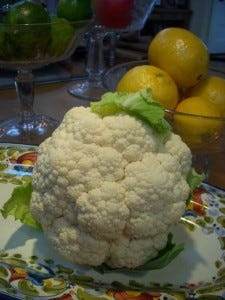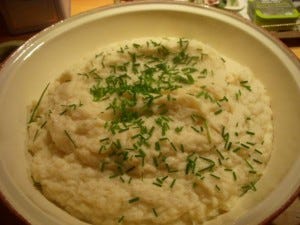Love In The Time of Cauliflower
I looked down at the proudly offered plate, and everything on it was white. Poached chicken, boiled potatoes, and something called “cauliflower-cheese.” It was my first-ever dinner in England, and who could have imagined that 24 hours later, I’d mee
I looked down at the proudly offered plate, and everything on it was white.
Poached chicken, boiled potatoes, and something called “cauliflower-cheese.” It was my first-ever dinner in England, and who could have imagined that 24 hours later, I’d meet the man who would become my husband. It took him only two weeks—and a handful of dinners in France—to capture my heart. I spent the next seven years as an English housewife, during which time I ate a great deal of white food. In those days, instead of writing cookbooks, I merely admired, collected, and cooked from them. My brown-haired, blue-eyed British boy—a Morgan Stanley euro-bond trader—was supposed to be the great love of my life; I naturally assumed that rather staid, but comfortable life would take place in Europe. Because no one ever gets married to get divorced. But life has a way of throwing curve-balls, and if you’re not careful one of them will hit you in the head and knock all your teeth out. That’s what happened to me, but by that time we were living in Spain, my blue-eyed boy having been unceremoniously fired by Mother Morgan, divested of all his offshore bonus’, and reduced to a mass of pale and quivering English jelly. A bit like cauliflower-cheese, really.
In Spain, I began to cook food with a great deal of color: tomatoes, peppers, olives, huge pink prawns, ruddy chorizo. As my cooking and cheeks gained color and the old bounce came back to my step, the Englishman seemed to deteriorate; he became pale and almost translucent, like an uncooked calamari. The rude and brilliant sun forced him indoors, to lick his wounds, wring hands over the empty bank-account, and make nefarious come-back plans. My path led in a different, more hopeful direction. The American pioneer inside me saw the road ahead littered with wonderful possibilities—I fermented a sourdough and baked my own bread, launched a catering business, planted a salad garden. I reached back to take hold of his hand, but found he had already offered it to another. In the end, our marriage couldn’t straddle the fault-line between white and color, shade and sun, regret and rebirth.
Now, I write cookbooks for a living, and no good food (especially a vegetable) is banned from my table just because it is white. In the way a good dress can be brought out again a decade or two later, shortened, re-accessorized, appreciated anew; so too cauliflower can come to my table once again. And, yes, emphatically, with cheese.
Consoling and Creamy Cauliflower Purée
(adapted from my book The Low-Carb Gourmet Ten Speed Press '04) Serves 6
* 2 small cauliflowers (1 1/2 to 1 3/4 pounds each), thick stalks and leaves discarded, separated into rough, lime-sized florets with about 1 inch of the stem attached * 1/2 cup heavy cream * 7 ounces Manchego or Gruyere cheese, grated on the large holes of a box grater * Fine sea salt and white pepper, preferably freshly ground
In the top of a steamer set over simmering water, steam the cauliflower for 20 to 25 minutes, until completely tender (test with a small, sharp knife). In a large food processor, combine the steamed cauliflower and cream; purée until completely smooth. Transfer to a warm bowl, fold in the cheese, about 3/4 teaspoon salt, and several turns of white pepper. Serve immediately or transfer to the top of a double boiler set over barely simmering water and hold for up to 30 minutes. (Or, cool, cover, and refrigerate for up to 6 hours; warm gently in a double boiler.)




